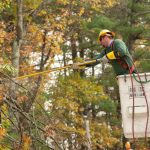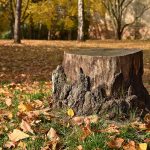Why yard renovations start with proper tree care
If you’re looking to make renovations to your yard, there’s many factors to consider before taking the plunge. Comparing costs, choosing design ideas, and knowing who to hire to do the job are just a few considerations. But perhaps you haven’t thought about one of the biggest (and potentially expensive) features of your yard: trees.
Any changes to the yard or external part of the home must begin with the trees growing on your property. They’re semi-permanent features that require extra considerations to avoid potentially pricey problems down the line.
Surface roots
Tree roots growing at or above the soil line are called surface roots. They can pose significant problems for potential renovations including new fencing, underground plumbing or fresh concrete for a patio or pathway. As roots grow, they can break pipes and enter the cracks in search of water. If trees are too close to paved areas, the roots can lift the pavement and pose a tripping hazard.
Surface roots can even make it difficult to perform general maintenance on your lawn, including mowing or simply growing grass. Depending on the severity of erosion and placement of the roots, you have a few options.
- If able to keep roots: Mow down grass growing beneath the tree and raze it to the ground with a weed-whipper. Once you’re at the bare dirt level, add 1-3 inches of bark mulch. This is a superior choice to soil because mulch allows more airflow to the roots. In addition, you won’t need to mow grass under the tree and run into root issues again in a few years. Mulch can also give the area around your tree a more professional, finished look.
- If some root removal is necessary: Sometimes, surface roots cannot be taken care of through adding mulch or soil and portions need to be removed. Be warned: There’s no guarantee that cutting tree roots won’t hurt or eventually kill the tree. Never remove more than 20% of surface roots at once. Wait two or three years before cutting more.
Trees adjacent to the home
As beautiful as trees are, they can cause serious damage to your home, especially to the roof. In fact, the National Storm Damage Center found that damage caused by trees accounts for more than $1 billion in property damage each year in the U.S. alone. Learn how to protect yourself and your property from preventable damage by addressing difficult trees before it’s too late.
- Overhanging branches: In high winds or stormy weather, tree branches can easily break and potentially rip off shingles as they fall to ground, leaving your roof vulnerable to future leaks. A general rule of thumb is your home should have a 10-foot radius around it that’s clear of any overhanging branches.
Additionally, it’s crucial to clear piles of leaves or needles that collect on the roof. These materials can trap moisture and cause damage to shingles and warp wooden support beams over time.
- Falling trees: By far the greatest capacity for damage for roofs comes from falling trees. Even medium-sized trees can cause major damage that will demand extensive and costly repairs. It’s a good idea to inspect any trees growing around the home once a year to ensure there’s no internal rot or damage that could cause falling trees in the future.
Tree removal
Removing a tree requires a professional’s handiwork to be done safely and correctly. If you have a problematic tree and aren’t sure what to do, give us a call at Inexpensive Tree Care and one of our experts will ensure that your trees are properly taken care so you can enjoy creating the yard you’ve always wanted.




